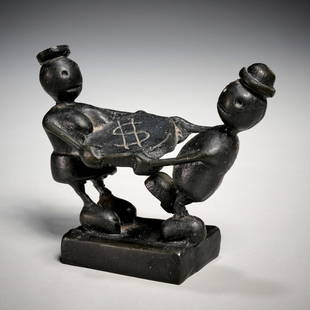
AN IMPORTANT SANDSTONE STELE OF MAHAVIRA, 16-18c.
Similar Sale History
View More Items in Sculptures & CarvingsRelated Sculptures & Carvings
More Items in Indian Sculptures & Carvings
View MoreRecommended Art
View More


















Item Details
Description
A LARGE AND IMPORTANT SANDSTONE STELE OF MAHAVIRA, MADHYA PRADESH, 16TH- 18TH CENTURY
Red sandstone, sculpted, carved and incised, well grown age-patina
Central India, Madhya Pradesh, 16th – 18th century
Mahavira sits in Dhyana asana on a simple throne in front of a halo, encompassed by a semicircle of sun rays, which themselves are surrounded by a foliate lotus band. Jina’s hands show the gesture of Dhyana mudra.
Mahavira was the twenty-fourth Tirthankara (ford-maker) of Jainism which was revived and re-established by him. After getting enlightened, Mahavira synthesized and revived the philosophies and promulgations of the ancient Śramaṇic traditions laid down by the first Jain tirthankara Rishabhdeva. In the Jain tradition, it is believed that Mahavira was born in the early part of the 6th century BC into a royal family in what is now Bihar, India. At the age of thirty, abandoning all worldly possessions, he left his home in pursuit of spiritual awakening and became an ascetic.
The wheel-shaped halo references his teachings which form the basis of the Jain philosophy: Ahimsa (non-violence), aparigraha (non-attachment), asteya (no theft), brahmacharya (chastisty), and satya (truthfulness). Behind his steadfast gaze, the nimbus holds several open lotus flowers, a symbol interchangeable with that of the sun, whose rays metaphorically radiate from his head.
Mahavira is usually depicted in a sitting or standing meditative posture with the symbol of a lion beneath him. Such a lion may have once been a separate component of an ensemble of which the present statue was the centerpiece. The earliest iconography for Mahavira is from archaeological sites in the north Indian city of Mathura. These are variously dated from the 1st century BC to the 2nd century AD. The day Mahavira was born is celebrated as Mahavir Janma-kalyanak (popularly known as Mahavir Jayanti), and the day of his liberation is celebrated by Jains as Diwali. In 1973, which was the 2,500th anniversary of the Nirvana (or Moksha) of Mahavira, monks of the various sects of Jainism assembled to resolve their differences and arrive at some commons points of agreement about the history and philosophy of Jainism.
Shape: Sculpture on a stele
Weight: 295 kilograms
Dimensions: Height 95 cm, width 64 cm, depth 41 cm
Condition: Excellent condition with losses, cracks and abrasions as well visible on the images in the catalogue and online
Provenance: German private collection
Literature comparison: For a related image of Mahavira, see Granoff, Victorious Ones: Jain Images of Perfection, New York, 2009, pp. 166-7, no. S04.
Auction result comparison: INDIAN, HIMALAYAN & SOUTHEAST ASIAN ART. Bonham’s, 14th March 2016, NEW YORK, lot 74. (for a related Mahavira sandstone stele, dated to the 10th century)
Red sandstone, sculpted, carved and incised, well grown age-patina
Central India, Madhya Pradesh, 16th – 18th century
Mahavira sits in Dhyana asana on a simple throne in front of a halo, encompassed by a semicircle of sun rays, which themselves are surrounded by a foliate lotus band. Jina’s hands show the gesture of Dhyana mudra.
Mahavira was the twenty-fourth Tirthankara (ford-maker) of Jainism which was revived and re-established by him. After getting enlightened, Mahavira synthesized and revived the philosophies and promulgations of the ancient Śramaṇic traditions laid down by the first Jain tirthankara Rishabhdeva. In the Jain tradition, it is believed that Mahavira was born in the early part of the 6th century BC into a royal family in what is now Bihar, India. At the age of thirty, abandoning all worldly possessions, he left his home in pursuit of spiritual awakening and became an ascetic.
The wheel-shaped halo references his teachings which form the basis of the Jain philosophy: Ahimsa (non-violence), aparigraha (non-attachment), asteya (no theft), brahmacharya (chastisty), and satya (truthfulness). Behind his steadfast gaze, the nimbus holds several open lotus flowers, a symbol interchangeable with that of the sun, whose rays metaphorically radiate from his head.
Mahavira is usually depicted in a sitting or standing meditative posture with the symbol of a lion beneath him. Such a lion may have once been a separate component of an ensemble of which the present statue was the centerpiece. The earliest iconography for Mahavira is from archaeological sites in the north Indian city of Mathura. These are variously dated from the 1st century BC to the 2nd century AD. The day Mahavira was born is celebrated as Mahavir Janma-kalyanak (popularly known as Mahavir Jayanti), and the day of his liberation is celebrated by Jains as Diwali. In 1973, which was the 2,500th anniversary of the Nirvana (or Moksha) of Mahavira, monks of the various sects of Jainism assembled to resolve their differences and arrive at some commons points of agreement about the history and philosophy of Jainism.
Shape: Sculpture on a stele
Weight: 295 kilograms
Dimensions: Height 95 cm, width 64 cm, depth 41 cm
Condition: Excellent condition with losses, cracks and abrasions as well visible on the images in the catalogue and online
Provenance: German private collection
Literature comparison: For a related image of Mahavira, see Granoff, Victorious Ones: Jain Images of Perfection, New York, 2009, pp. 166-7, no. S04.
Auction result comparison: INDIAN, HIMALAYAN & SOUTHEAST ASIAN ART. Bonham’s, 14th March 2016, NEW YORK, lot 74. (for a related Mahavira sandstone stele, dated to the 10th century)
Buyer's Premium
- 27%
AN IMPORTANT SANDSTONE STELE OF MAHAVIRA, 16-18c.
Estimate €3,000 - €6,000
11 bidders are watching this item.
Shipping & Pickup Options
Item located in Vienna, atSee Policy for Shipping
Payment

TOP









































































![[Custer, Little Big Horn] Eagle Elk, Oglala Sioux Warrior: “I was about 25 the summer we fought Long Hair and I still believed we could drive the white men from our country. I’m a little sad yet about that fight, although it was our finest victory.”](https://p1.liveauctioneers.com/7226/322253/173251540_1_x.jpg?height=310&quality=70&version=1710004847)



